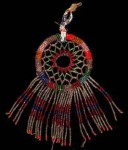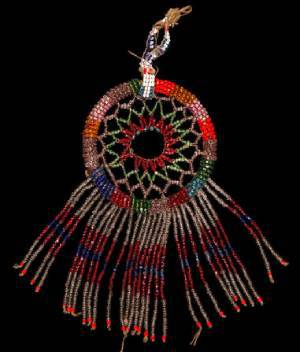
 Dreamcatcher (Created around 1930-1935) - From the personal collection of Paul Coze, Musée de l'Homme, Quai Branly collection.
Dreamcatcher (Created around 1930-1935) - From the personal collection of Paul Coze, Musée de l'Homme, Quai Branly collection.
It can be found everywhere across the Atlantic, from highway gas stations to other charms in the shops of New Age Mecca in Sedona, Arizona, to schools marked by tragic murderous shootings, such as Columbine.
The dreamcatcher — or attrape-rêve in French — is an Ojibway protective artefact. There is relatively little scientific literature on the subject, except for the references made by ethnomusicologist Frances Densmore in his Chippewa Customs, first published in 1929. The dream catcher is a small hoop that contains a weave that reproduces the spider’s web pattern. It was once made with nettle stems that were coloured red with the sap of Canadian Bloodroot or the bark of the American plum tree. During his travels to 6 reserves in Minnesota, Wisconsin, and the Province of Ontario in Canada, Densmore noted numerous dream catchers over cradle boards. Their purpose was to prevent nightmares and leave the way open to pleasant and beneficial dreams for children.
Since the late 1960s, many variants (willow, metal) of the protective object have been marketed. The dissemination of this symbol outside the Ojibway populations — like the development of the Sun Dance outside the Plains Tribes — has, sometimes, been interpreted as an expression of the emergence of a pan-Indian movement. Nevertheless, the cultural appropriation of this symbol by non-natives continues to raise the question of the interpretation of indigenous dreams and their potential universalist dimension.
For the First Peoples, the dream is as real as reality, its content, therefore, cannot be mediated by any grid of reading. However, the first transcriptions of Amerindian dreams reflect the need for the researcher to have conceptual tools to categorize them. With his The Dream in Primitive Cultures (1935), anthropologist Jackson Stewart Lincoln created the category of “culture pattern dream” or dream with a special tribal meaning. This culturalist approach aims to bring out, within individual dreams, patterns that inform on the place of the individual in the social and spiritual organization of the tribe.
These writings provide information on the causal relationship between physical and psychological disorder and — real or dreamed — encounter with natural elements (plants, meteorological phenomena, rocks, animals, etc.) They also show that based on a tribal group, the same content has different meanings. Thus, anthropologist Clyde Kluckhohn points out in the book The Navahos (1948) the fatal premonitory associated with the dreams of dead people, which often leads to the destruction of the hogan (traditional dwelling) in which the dreamer had nightmares. According to Dorothy Way Eggan, who gathered a body of 600 dreams told by Hopis informants, including Chief Don Talayesva, famous for his autobiography Soleil Hopi (Plon, 1959). According to him, it is dreaming of the yucca root that foreshadows death, such as snakes and venereal diseases and, to be conjured a nightmare must be told, even if it means pulling a speaker out of bed in the middle of the night. At the end of his story, the dreamer must immediately leave his home and spit 4 times.
The book Psychotherapy of a Plains Indian (New York, 1951) by Georges Devereux, considered the foundation of ethnopsychoanalysis, is fully part of a psychoanalytic cure conducted in a clinical environment, at the Winter Veterans Hospital in Topeka, Kansas. Georges Devereux made his debut as a psychoanalyst after meeting with Jimmy Picard, a Blackfoot veteran suffering from traumatic neurosis following his participation in World War II. Devereux insists on the need to understand the culture of the analyzed. His work is exempt from condescending ethnocentric remarks, profusely present in older publications such as William Morgan’s 1932 article. Dreams in which Yeis, sacred Navajo beings, appeared were relegated to the status of superstitions, and the dreamer, a respected shaman, was described as infantile. Yet, despite this salutary openness, North American Indian dreams are often apprehended in the light of western criteria. Perhaps, what remains to be experienced is what Tobasonakwut Kinew, a scholar and Anishinabe sage, recommends: “Seek your dream, live your dream, understand your dream and move forward with your dream.”
Read more in the dictionary : Neurodiversity
Read the paper in French : Attrape-rêve
References :
Frances Densmore, Chippewa Customs. U.S. Government Printing Office, 1929. (Reprint, Minnesota Historical Society Press, 1979).
Dorothy Way Eggan“The Significance of Dreams for Anthropological Research.” American Anthropologist, 1949, vol. 51, pp. 177–198.
To quote this paper : Nausica Zaballos, "Dreamcatcher" in Hervé Guillemain (dir.), DicoPolHiS, Le Mans université, 2021.